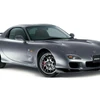The McLaren F1-beater likely to be among the last of its kind

- 'Spiritual successor' to McLaren F1 is on the way
- One of the last naturally aspirated supercars
- Lighter, faster, and due for production in 2022
The McLaren F1 has long been a flagship among supercar enthusiasts, offering a near perfect balance between weight, power and styling, and has long been the fastest naturally aspirated road car of all time.
But that design is now nearly 30 years old, and while most would still crave to see such a legendary car on the driveway, plans are afoot for a natural successor.
Enter South African Gordon Murray. Murray is one of the most esteemed car designers in the world, responsible for a string of iconic Formula One cars in the 1970s and 1980s before becoming a key part of the McLaren F1’s design team.
Now though, Murray has gone it alone and created his own company, Gordon Murray Automotive. And what he’s been creating is an absolute monster. It is called the Type 50, and it’s as close as we’re ever likely to get to a McLaren F1 successor.
In a world of hybrids, turbocharging and electrification, the T.50 is likely to be one of the last of its kind to use a naturally aspirated engine. Murray has chosen wisely; a mighty 3.9 litre Cosworth V12 producing over 650 horsepower is under the bonnet, with a glorious 12,000 RPM soundtrack accompanying it. Mated to this will be a six speed H-pattern manual gearbox built by Xtrac.
As you’d expect from the man who designed the McLaren F1, the T.50 bears many similarities to its predecessor, with carbon fibre bodywork, dihedral doors and its three-seater layout including a central driving position among the carryover concepts.
But 30 years is a lot of time for progress to be made, and Murray has optimised everything in the pursuit of lightness and performance, right down to the foot pedals and even the car’s badges!
Performance wise there’s an improvement too, with more horsepower, and a kerb weight saving of over 150 kilogrammes compared to the McLaren F1, meaning the T.50 has one of the highest power-to-weight ratios among its class.
Partly due to the lack of EV batteries or hybrid technology, but mainly as a result of Murray’s extraordinary eye for detail, the T.50 will be the lightest supercar available on the current market and feature the most advanced aerodynamics of any road car.
Murray has utilised his experience of ground-effect innovations to an all-new level with a 400mm fan at the rear, working with the underbody airflow to create massive rear downforce, ensuring the car goes in line with his quest to “deliver the purest, most rewarding driving experience of any supercar ever built.” The fan concept is no stranger to Murray, he first used the concept in 1978 on the famous Brabham BT46B ‘Fan Car.’ The concept proved so quick that Brabham’s rivals ensured it was banned by the next race!
With an eye for design and for compactness, the T.50 will not feature conventional wing mirrors, but will instead use screens inside the cabin. Despite being fully weight optimised, the car will still include infotainment, media and sat nav, with the system featuring 10 speakers, 700 watts of power and weighing in at just 4.3 kilos.
Other practicalities include storage lockers, meaning the vehicle can be used for more than just a blast down the country lanes, with storage space in numerous locations inside the cabin and with side lockers accessed from outside the car. Meanwhile for those supermarket dashes, the engine can go into a separate power mode with a limited RPM of 9,500 and 600 horsepower.
The T.50 is expected to enter production in 2022 and will be manufactured at a purpose-built facility in Surrey, with all major components bespoke and sourced from UK companies.
Just 100 will be built, with a price tag of around £2.8 million in the UK. The vast majority have already been bought, with a £600,000 deposit.
Prototyping is already well underway, and the car made its track debut at Dunsfold Aerodrome earlier this month, with Murray at the wheel.
Once the road cars have been completed, a limited run of 25 track-only variants will go into production, which will be faster, lighter, and feature further refined aerodynamics.
Quite frankly, this promises to be one of the most exceptional cars ever built.
Richard Randle is a motorsport PR professional working with the UK’s top racing circuits and the UK’s premier single-seater category, the BRDC British F3 Championship.


